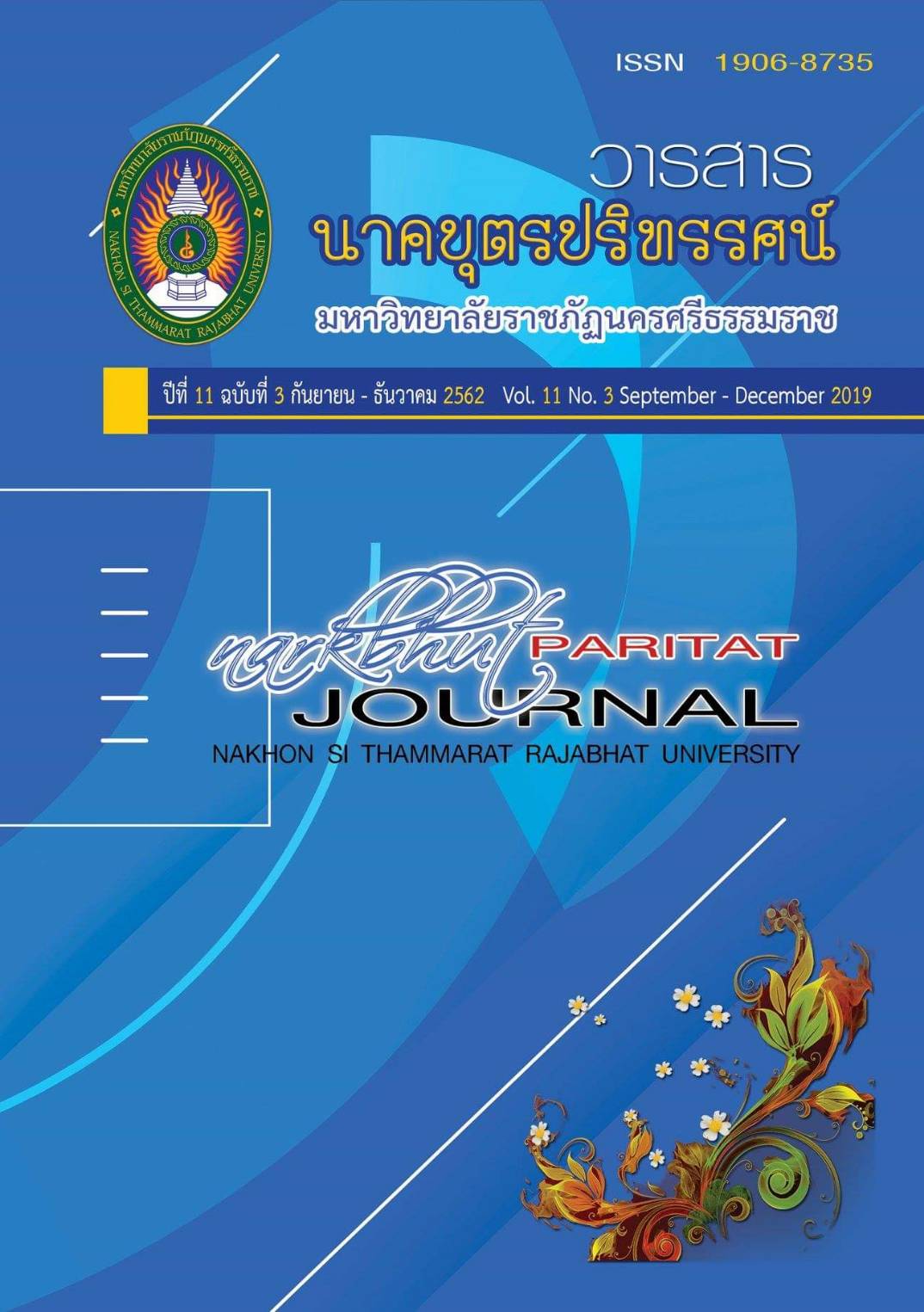การวิจัยเรื่อง สาคูศึกษา : การพัฒนาหลักสูตรท้องถิ่นเพื่อการอนุรักษ์ป่าสาคูอย่างยั่งยืน Sago Palm studies : the developing local curriculum for preserve Sago Palm forest as sustainable
Main Article Content
Abstract
การศึกษานี้มีจุดประสงค์เพื่อศึกษาการใช้ประโยชน์และการจัดการป่าสาคูในพื้นที่บ้านสากเหล็ก และร่วมกันจัดทำหลักสูตรท้องถิ่น “สาคูศึกษา” ให้กับโรงเรียนวัดสากเหล็ก ตำบลอินคีรี อำเภอพรหมคีรี จังหวัดนครศรีธรรมราช เป็นการวิจัยประยุกต์ (Applied Research) ใช้หลักการวิจัยเชิงคุณภาพ (Qualitative Research) และวิจัยเชิงปฏิบัติการแบบมีส่วนร่วม (Participatory Action Research: PAR) มีการทำงานวิจัยร่วมกันระหว่างทีมนักวิจัยกับโรงเรียนและชุมชน
ผลการศึกษา ช่วงแรกข้อมูลสภาพทั่วไปด้านภูมิศาสตร์ ภูมิประเทศเป็นที่ราบ สภาพพื้นที่เป็นดินร่วน อาชีพสำคัญของชุมชน คือ การทำนา แต่ในปัจจุบันมีการปลูกยางพาราและปาล์มน้ำมันในพื้นที่นา มีลักษณะภูมิอากาศที่ทำให้เกิดน้ำท่วมน้ำหลากในช่วงเดือนพฤศจิกายน–ธันวาคม ด้านประวัติความเป็นมาของชุมชนสากเหล็กเป็นชุมชนดั้งเดิม มีการขุดพบแท่งเหล็ก มีลักษณะคล้ายสากตำข้าวโบราณ พืชสำคัญ คือ สาคู (Sago) พืชในตระกูลปาล์ม (palm family) ชื่อวิทยาศาสตร์ Metroxylon sagus Rottb. ขึ้นบริเวณพื้นที่ชุ่มน้ำ ทำให้มีความหลากหลายของพันธุ์พืช และสัตว์ เป็นพืชซับน้ำ กักเก็บน้ำ ภูมิปัญญาการใช้ประโยชน์ คือ ลำต้นที่มีดอก อายุ 6-10 เดือน จะสะสมแป้งไว้ได้มาก จึงมีการแปรรูปเป็นแป้งสาคู เพื่อเป็นอาหารของคน และลำต้นนำไปเลี้ยงเป็ด ไก่ และด้วงสาคู ใบสาคูนำมาเย็บตับสาคู ทางใบนำมาสานเสื่อ ข้องดักปลาไหล และกั้นฝาผนัง ผลมีรสฝาดใช้ทานหรือทำยา รากใช้ทำยา ช่วงที่ 2 การพัฒนาหลักสูตรสาคูศึกษา : ท้องถิ่นสากเหล็ก เป็นรายวิชาเพิ่มเติม สำหรับนักเรียนระดับประถมศึกษา 4-6 เป้าหมายเพื่อส่งเสริมให้เห็นคุณค่าภูมิปัญญาการนำสาคูมาใช้ประโยชน์ทางเศรษฐกิจของครอบครัว เละเพื่อให้เกิดการอนุรักษ์พืชท้องถิ่นที่มีประโยชน์ ทั้งทางด้านวิถีชีวิต และสภาพแวดล้อมทางธรรมชาติ นำความรู้และภูมิปัญญาการใช้ประโยชน์จากสาคูเป็นเนื้อหาสาระ การจัดกิจกรรมการเรียนรู้เชิงรุก (Active Learning) แนวคิดการจัดการเรียนรู้กิจกรรมเป็นฐาน (ABL: Activity-Based Learning) กิจกรรมการศึกษา สืบค้น และปฏิบัติงานกลุ่ม สร้างความรู้ระยะยาว สามารถพัฒนาทักษะการทำงานร่วมกับผู้อื่น การคิดวิเคราะห์ และการแก้ปัญหา สามารถสร้างความตระหนัก ความภูมิใจให้กับผู้เรียนจากการมีส่วนร่วมในการเรียนรู้
The purpose of this study is to find about utilization and development of sago palm forest in Baan Sak Lhek and managing the local curriculum for “sago palm study” for Wat Sak Lhek school in Inkiri subdistruct, Phromkiri disctrict Nakhon Si Thammarat. This study is an applied research that used Qualitative research and participatory Action research (PAR) as a tool for research along with working together with researcher team, School and villagers.
The result of this research shown that the geography of villages is a plain with loam soil. The main occupation in the area is farming but in present day farmer plants the rubber tree and palm tree in farming area. The weather in this area is in tropical zone, it’s will have a flooding in November-December, Ban Sak Lhek is an original village since long time ago. Iron bar which are look like pestle was found in this village. The main plant that found in this village is Sago, palm family tree (Scientific name: Metroxylon sagus rottb.) It’s grown at wetland area so it’s make a variety of environment in this area including other plants, animal. Sago palm tree is a water absorbed plant that helps absorbing water. Sago palm tree has many uses such as 6-10 months old tree will use to make edible flour because the tree is collecting a lot of carbohydrate inside. The trunk is used for making a food for duck, chicken and Sago beetle’s larva. The leaves can be weaved in row to make traditional house’s roof, mat and fishing cage. The fruit and root can use to make a Thai medicine. In 2nd stages of this research is for developing the local curriculum “sago study” to become a optional subject for Pratom 4-6 in Village’s School to make the students understand, know the importance of Sago palm tree, can use the learned knowledge to adapted using for making an active learning& Activity-based learning(ABL) able to work in groups with other people can developed the team-working skills able to analyze and solved the problem that was found and have self-consciousness and proudness for learners from participating an activities.
Article Details
References
Department of Curriculum and Instruction Development. (1997). Manual for curriculum development based on local needs. (2nd ed), Bangkok: Kurusapa Printing Ladphrao. (In Thai)
Chuaratanaphong, J. (1996). Curriculum development: principles and practices. Bangkok: Aleen Press.
Sriroth, K., Piyachomkwan, K., Chonkuphon, R., Chotineeranat, S., Hathairarakham, S. & Chanyawilas, S. (1999). Properties and utilisation of sago palm (Metroxylon spp.) in Thailand. (In Thai)
Office of the Education Council. (2017). The National Education Plan (2017-2036). Bangkok: prikwarn-graphic.
Prida Chanthajit. (2008). The Local Curriculum Development on the Subject of Bohyang Study under Social Study Religion and Culture Substance for the Forth Grade Level Students at Mahavajiravudh Changwat Songkhla School. (Thesis Master of Education in Curriculum and Instruction) . Songkhla; Thaksin University. (In Thai)
Prasitwutthiwech, W. (1999). Curriculum development: persist in local areas. Bangkok: loveandlippress. (In Thai)
Wongyai, W & Phatphol, M. (2010). From the core curriculum to school curriculum: a new paradigm of development. (Type 3). Bangkok: Charansanitwong Printing. (In Thai)
Panich, V. (2013). Way of learning for students in the 21st century. (3rd edition). Bangkok: Sodsri-Saritwong Foundation. (In Thai)
Bonwell, C. C., & Eison, J. A. (1991). Active Learning: Creating Excitement in the Classroom.
ASHE-ERIC Higher Education Report. Washington DC: School of Education and Human Development, George Washington University.
Dale, E. (1969). Audio-visual methods in teaching. (3rd ed). New York: The Dryden Press.Deries,
Meyer, C., and Jones T.B.(1993). Promoting Active Learning, Strategies for the College Classroom. San Francisco : Jossey-Bass.
Oliva, Peter F. (2009). Developing the curriculum. (7th ed). Boston: Allyn and Bacon.
Prince, M. (2004). Does Active Learning Work? A Review of the Research. Journal of Engineering Education. 93(3), 223-232.
Taba , Hilda. (1962). Curriculum Development : Theory and Practice. New York: Harcourt. Brace and World Inc,
Saylor, J. G. & W.M. Alexander (1974). Planning Curriculum For Schools. New York: Holt, Rinehart and Wiston. http://www.unco.edu/cet1/Sir2staring_outcome/
documents/ krathwohl.pdf
Tyler, Ralph W. (1949). Basic Principle of Curriculum and Instruction. Chicago: The University of Chicago Press.


